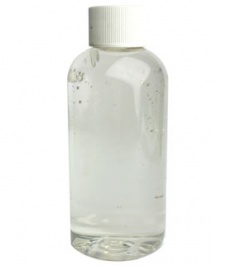Glycerin (Glycerol)
| Infobox on Glycerin (Glycerol) | |
|---|---|
| Example of Glycerin (Glycerol) |  |
| Facts | |
| Origin | - |
| Stowage factor (in m3/t) | 1,70 m3/t (drums) |
| Humidity / moisture | - |
| Ventilation | - |
| Risk factors | See text |
Glycerin (Glycerol)
Contents
Description
Glycerol (or glycerine, glycerin) is a simple polyol compound. It is a colourless, odourless, viscous liquid that is widely used in pharmaceutical formulations. Glycerol has three hydroxyl groups that are responsible for its solubility in water and its hygroscopic nature. The glycerol backbone is central to all lipids known as triglycerides. Glycerol is sweet-tasting and of low toxicity.
Triglycerides found in Fats and Oils are by definition esters of glycerol with long-chain carboxylic acids; the hydrolysis (saponification) or transesterification of these triglycerides produces stoichiometric quantities of glycerol. In this scheme, glycerol is produced as a co-product in the production of long-chain carboxylate salts used as soaps.
It is also a byproduct of the production of biodiesel via transesterification. This form of crude glycerin is often dark in appearance with a thick, syrup-like consistency. Triglycerides are treated with an alcohol such as ethanol with catalytic base to give ethyl esters of fatty acids and glycerol.
Glycerol from triglycerides is produced on a large scale, but the crude product is of variable quality, with a low selling price. It can be purified, but the process is expensive. As a result, a good fraction of crude glycerol is disposed of as waste. Some glycerol is burned for energy, but the heat value is low.
That said, crude glycerol from the hydrolysis of triglycerides can be purified by treatment with activated carbon to remove organic impurities, alkali to remove unreacted glycerol esters, and ion exchange to remove salts. High purity glycerol (> 99.5%) is obtained by multi-step distillation; vacuum is helpful due to the high boiling point of glycerol (290°C).
Synthetic glycerol refers to material obtained from non-triglyceride sources. Glycerol may also be produced by various routes from propylene. The epichlorohydrin process is the most important; it involves the chlorination of propylene to give allyl chloride, which is oxidized with hypochlorite to dichlorohydrins, which reacts with a strong base to give epichlorohydrin. Epichlorohydrin is then hydrolyzed to give glycerol. Chlorine-free processes from propylene include the synthesis of glycerol from acrolein and propylene oxide.
Because of the emphasis on biodiesel, where glycerol is a waste product, the market for glycerol is depressed, and these old processes are no longer economical on a large scale. In fact, due to the glycerol glut, efforts are being made to convert glycerol to its precursors, such as acrolein and epichlorohydrin.
Derivation
(1) Byproduct of soap manufacture
(2) from propylene and chlorine to form allyl chloride which is converted to the dichlorohydrin with hypochlorous acid; this is then saponified to glycerol with caustic solution
(3) isomerization of propylene oxide to allyl alcohol, which is reacted with peracetic acid; the resulting glycidol is hydrolysed to mglycerol;(4) hydrogenation of carbohydrates with nickel catalyst; (5) from acrolein and hydrogen peroxide.
Method of purification: Redistillation, ion-exchange techniques.











